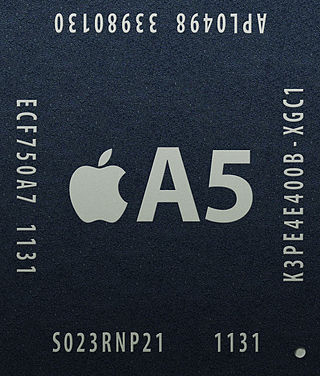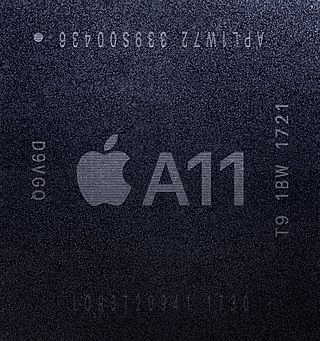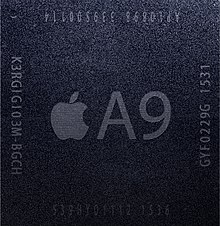The transistor count is the number of transistors in an electronic device. It is the most common measure of integrated circuit complexity. The rate at which MOS transistor counts have increased generally follows Moore's law, which observes that transistor count doubles approximately every two years. However, being directly proportional to the area of a chip, transistor count does not represent how advanced the corresponding manufacturing technology is: a better indication of this is transistor density.
The "14 nanometer process" refers to a marketing term for the MOSFET technology node that is the successor to the "22 nm" node. The "14 nm" was so named by the International Technology Roadmap for Semiconductors (ITRS). Until about 2011, the node following "22 nm" was expected to be "16 nm". All "14 nm" nodes use FinFET technology, a type of multi-gate MOSFET technology that is a non-planar evolution of planar silicon CMOS technology.

The Apple A5 is a 32-bit system on a chip (SoC) designed by Apple Inc. and manufactured by Samsung. The first product Apple featured an A5 in was the iPad 2. Apple claimed during their media event on March 2, 2011, that the ARM Cortex-A9 central processing unit (CPU) in the A5 is up to two times faster than the CPU in the Apple A4, and the PowerVR SGX543MP2 graphics processing unit (GPU) in the A5 is up to nine times faster than the GPU in the A4. Apple also claimed that the A5 uses the same amount of power as the A4.
In semiconductor manufacturing, the International Roadmap for Devices and Systems defines the "5 nm" process as the MOSFET technology node following the "7 nm" node. In 2020, Samsung and TSMC entered volume production of "5 nm" chips, manufactured for companies including Apple, Marvell, Huawei and Qualcomm.
In semiconductor manufacturing, the "7 nm" process is a marketing term for the MOSFET technology node following the "10 nm" node, defined by the International Technology Roadmap for Semiconductors. It is based on FinFET technology, a type of multi-gate MOSFET technology.

Apple silicon refers to a series of system on a chip (SoC) and system in a package (SiP) processors designed by Apple Inc., mainly using the ARM architecture. They are the basis of Mac, iPhone, iPad, Apple TV, Apple Watch, AirPods, AirTag, HomePod, and Apple Vision Pro devices.

The Apple A6 is a 32-bit package on package (PoP) system on a chip (SoC) designed by Apple Inc. that was introduced on September 12, 2012, at the launch of the iPhone 5. Apple states that it is up to twice as fast and has up to twice the graphics power compared with its predecessor, the Apple A5. Software updates for devices using this chip ceased in 2019, with the release of iOS 10.3.4 on the iPhone 5 as it was discontinued with the release of iOS 11 in 2017.

The Apple M-series coprocessors are motion coprocessors used by Apple Inc. in their mobile devices. First released in 2013, their function is to collect sensor data from integrated accelerometers, gyroscopes and compasses and offload the collecting and processing of sensor data from the main central processing unit (CPU).
This is a comparison of ARM instruction set architecture application processor cores designed by ARM Holdings and 3rd parties. It does not include ARM Cortex-R, ARM Cortex-M, or legacy ARM cores.
The Apple A8 is a 64-bit ARM-based system on a chip (SoC) designed by Apple Inc. It first appeared in the iPhone 6 and iPhone 6 Plus, which were introduced on September 9, 2014. Apple states that it has 25% more CPU performance and 50% more graphics performance while drawing only 50% of the power of its predecessor, the Apple A7. The latest software updates for the 1.1GHz and 1.4GHz variants systems using this chip are iOS 12.5.7, released on January 23, 2023 as they were discontinued with the release of iOS 13 in 2019, and 1.5 GHz variant for the iPad Mini 4 is iPadOS 15.8.2, released on March 5, 2024 as it was discontinued with the release of iPadOS 16 in 2022, while updates for the 1.5 GHz variant continue for Apple TV HD. The A8 chip was discontinued on October 18, 2022, following the discontinuation of the Apple TV HD.

The Apple A8X is a 64-bit ARM-based system on a chip (SoC) designed by Apple Inc. and manufactured by TSMC. It first appeared in the iPad Air 2 and only is used in the iPad Air 2, which was announced on October 16, 2014. It is a variant of the A8 inside the iPhone 6 family of smartphones and Apple states that it has 40% more CPU performance and 2.5 times the graphics performance of its predecessor, the Apple A7. The latest software update for the iPad Air 2 using this chip is iPadOS 15.8.2, released on March 5, 2024, as it was discontinued with the release of iPadOS 16 in 2022 due to hardware limitations of the A8X.

The iPhone 6s and iPhone 6s Plus are smartphones that were designed, developed, and marketed by Apple Inc. They are the ninth generation of the iPhone. They were announced on September 9, 2015, at the Bill Graham Civic Auditorium in San Francisco by Apple CEO Tim Cook, with pre-orders beginning September 12 and official release on September 25, 2015. They were succeeded by the iPhone 7 and iPhone 7 Plus on September 7, 2016 and were discontinued with the announcement of the iPhone XS, iPhone XS Max, and iPhone XR on September 12, 2018.

The Apple A9X is a 64-bit ARM architecture-based system on a chip (SoC) designed by Apple Inc. It first appeared in the iPad Pro, which was announced on September 9, 2015 and was released on November 11, 2015. The A9X has the M9 motion coprocessor embedded in it, something not seen in previous chip generations. It is a variant of the A9 and Apple claims that it has 80% more CPU performance and twice the GPU performance of its predecessor, the A8X.
Qualcomm Kryo is a series of custom or semi-custom ARM-based CPUs included in the Snapdragon line of SoCs.

The Apple A10 Fusion is a 64-bit ARM-based system on a chip (SoC), designed by Apple Inc. and manufactured by TSMC. It first appeared in the iPhone 7 and 7 Plus which were introduced on September 7, 2016, and is used in the sixth generation iPad, seventh generation iPad, and seventh generation iPod Touch. The A10 is the first Apple-designed quad-core SoC, with two high-performance cores and two energy-efficient cores. Apple states that it has 40% greater CPU performance and 50% greater graphics performance compared to its predecessor, the Apple A9. The Apple T2 chip is based on the A10. On May 10, 2022, the iPod Touch 7th generation was discontinued, ending production of A10 Fusion chips. The latest software updates for the iPhone 7 & 7 Plus including the iPod Touch 7th generation variants systems using this chip are iOS 15.8.2, released on March 5, 2024, as they were discontinued with the release of iOS 16 in 2022, while updates for the iPad variants systems using this chip are still supported.

The Apple A11 Bionic is a 64-bit ARM-based system on a chip (SoC), designed by Apple Inc. and manufactured by TSMC. It first appeared in the iPhone 8 and 8 Plus, and iPhone X which were introduced on September 12, 2017. Apple states that the two high-performance cores are 25% faster than the Apple A10's and the four high-efficiency cores are up to 70% faster than the two corresponding cores in the A10. The A11 Bionic chip was discontinued on April 15, 2020, following the discontinuation of the iPhone 8 and 8 Plus. The latest software update for the iPhone 8 & 8 Plus and iPhone X using this chip was iOS 16.7.6, released on March 5, 2024, as they were discontinued with the release of iOS 17 in 2023.

The Apple A15 Bionic is a 64-bit ARM-based system on a chip (SoC) designed by Apple Inc. It is used in the iPhone 13 and 13 Mini, iPhone 13 Pro and 13 Pro Max, iPad Mini, iPhone SE, iPhone 14 and 14 Plus and Apple TV 4K.

The Apple A16 Bionic is a 64-bit ARM-based system on a chip (SoC) designed by Apple Inc. and manufactured by TSMC. It is used in iPhones 14 Pro and 14 Pro Max, and 15 and 15 Plus.

iPhone and iPod Touch models released between 2007 and 2009 used system on a chip (SoC) circuits designed by Samsung and manufactured to Apple's specifications. Two such SoCs were used: the Samsung S5L8900, used in the first-generation iPhone, the iPhone 3G, and the first-generation iPod Touch, and the Samsung S5L8920, used in the iPhone 3GS and the third-generation iPod Touch. Both chips belong to Samsung's S5L family of SoCs.















